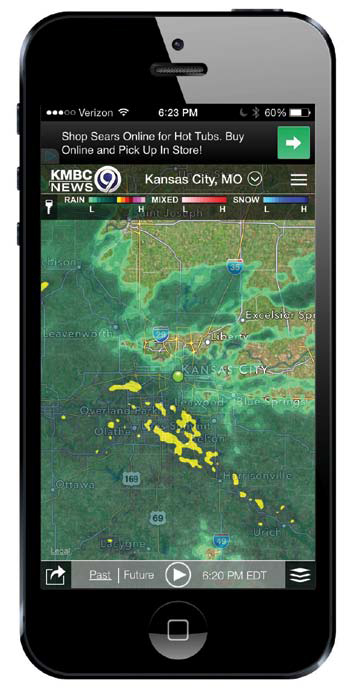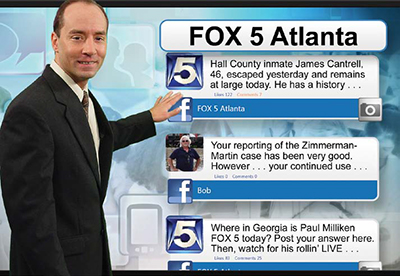Web, Social Media Driving Weather Graphics
ALEXANDRIA, VA.—Cisco estimates that mobile data consumption will increase 18 times between 2011 and 2016. Neilson reports that 30 million consumers watch television content through their smartphones, and according to Mobile-Marketer, The Weather Channel gets 600 to 700 percent higher click-through rates on mobile display ads when compared to desktop banners.
Clearly, there is pressure on weather content providers to capitalize on the Web and the mobile market as consumers diversify their weather sources from traditional TV/cable broadcasts to “cyber” renditions of the weather which they expect will tell them everything they need to know about weather conditions anywhere.

WSI says its broadcast customers that use the company’s Max Mobile App report more than 500,000 downloads and sponsorships exceeding $250,000. “Smartphone penetration in the U.S. is now 69.6 percent and nearly 75 percent among weather consumers, and a recent study found that nearly 80 percent of smartphone users reach for the device first thing in the morning before doing anything else,” said Doug Dempster, vice president, Media Digital Products at WSI in Andover, Mass. “That now makes the small screen the first screen in the morning no matter how early the morning newscasts start. This is a great opportunity for broadcasters to reach their audiences with mobile weather information they need to start their day and drive them to the newscast.”
DYNAMIC AND INTERACTIVE
Weather broadcasters understand this, but they also know that reinventing weather graphics from more stationary formats of TV/cable broadcasts to the dynamic and interactive video content that consumers expect will play on the limited data footprints of their mobile devices, is a major challenge. So, too, is establishing a mobile/Web presence for weather that can still capitalize and identify with the brand value that broadcasters have already established on television.
“Today’s consumers want hyper-local, minute-by-minute forecasts to make more informed decisions about their short-range activities, such as traveling, sporting, or other outdoor events, and they also want photorealisic forecasts for specific locations,” said Ryan Ayres, vice president of display systems and service at Accuweather in State College, Pa. “That’s why we focus on enabling TV newsrooms to tightly integrate weather forecasts with other newsroom stories around crime, traffic and other real-time information and social media posts from viewers.”
The integration includes the ability to incorporate graphics and content into mobile that consumers have grown accustomed to in traditional broadcasts, such as the forecast of tomorrow’s weather or the weekend outlook. Conversely, broadcasters must find ways to incorporate Web-derived content elements (like social media) into broadcasts.
SHORTER, MORE FOCUSED
Just how do these new demands alter the approach to weather graphics for broadcasters?
Get the TV Tech Newsletter
The professional video industry's #1 source for news, trends and product and tech information. Sign up below.
Mobile devices have limited data footprints, constrained by less memory, storage and processing, and significantly smaller screen sizes than traditional television. Internet service providers in many areas of the country also have bandwidth constraints that impede the quality of video downloads and streaming. “Patterns of use are different as well,” said Dempster. “We encourage clients to produce shorter, more focused video content for mobile use versus longer ‘complete weather story’ segments, with larger graphics for the smaller mobile device screens.”
Then there’s the issue of limited time. “The constraint of time to complete a forecast is removed with mobile,” said Eggestad. “The user only spends time watching what he wants, like a detailed hour-by-hour forecast of San Francisco to see if fog will roll in and prevent watching the game in the park. By providing content-rich and navigation-sensitive displays on mobile, advanced users will get additional value from being given access to more data on an interactive platform than through a broadcast.”

Accuweather’s StoryTeller Interactive Touchscreen News Solution The goal, then, for weather broadcasters is to maintain brand strength and consumer loyalty and to continue to monetize both on-air and mobile delivery as they expand to mobile. “These broadcasters want to remain relevant while dealing with the challenges of dealing with a fractured audience that wants to access weather through an assortment of channels,” said Dempster.
From a technical standpoint, weather content and graphics must be sufficiently flexible to enable them to be repurposed for different media (broadcast, mobile, etc.) with a few clicks of a mouse. Automation can be built into content editors that properly “sizes” graphics for the broadcast and mobile platforms they are targeted for.
“For all of these reasons, we need to support a wide variety of browsers, mobile devices, operating systems, and we need to think about a fallback for some features so we can support older devices,” said Dempster.
PUTTING IT ALL TOGETHER
To answer the challenges of weather content channel diverisification, solutions providers have responded with automation that broadcasters can simply “plug in” to their weather content preparation cycles, without having to burden their IT departments with major technical development projects.
Eggestad explained how the automation works: “A meteorologist prepares the weather content for the broadcast, and the information gets stored in a database. From this database, an application we provide pulls the content for broadcast and can also redigitize it for display on mobile devices. The process is entirely automated. The database the application works with can obtain a variety of weather content. So, for instance, if you need to pull the weather for Naples, Florida, you can do that—and send it out to broadcast and mobile devices. If, on the other hand, you need weather content for Los Angeles, you can also pull, digitize and deliver that information.”
The key is the automated workflow that can redigitize broadcast content to work on mobile devices—and by doing so, keep broadcasters’ brand images consistent across all delivery channels.
Mobile device use is exponentially growing, which means the timing couldn’t be better for automated weather content delivery technology. In the face of this, broadcasters must respond with engaging weather content and graphics, while continuing to build on the on-air credibility and brands they have already established.
“Bridging the generation/socio-economic gap with respect to TV vs. online/ mobile audiences is going to be important as more weather broadcasting revenue is going to come from non-broadcast products,” said Eggestad. “TV broadcast weather is not going to disappear, either. That’s why broadcasters that find ways to monetize both their Internet and ‘non-Internet’ audiences will have an advantage.”
